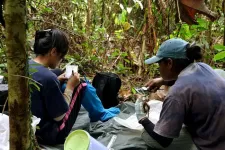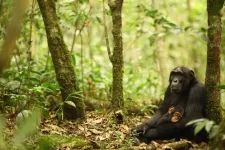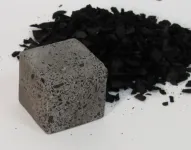(Press-News.org) Yang Zhang, PhD, and Jinjun Shi, PhD, both of the Center for Nanomedicine and Department of Anesthesiology, Perioperative and Pain Medicine at Brigham and Women’s Hospital, are co-senior authors of a paper published in ACS Nanoscience Au, “Lipid Nanoparticle Delivery of mRNA and siRNA for Concurrent Restoration of Tumor Suppressor and Inhibition of Tumorigenic Driver in Prostate Cancer.”
How would you summarize your study for a lay audience?
Most cancers occur when there is an imbalance of cellular growth and inhibition, causing cells to grow rapidly and form tumors in the body. For example, advanced prostate cancer (PCa) is often linked to changes in the activity of a tumor suppressor, called phosphatase and tensin homologue deleted on chromosome 10 (PTEN), and a widely studied pro-tumorigenic transcription factor, called androgen receptor (AR). However, no therapies exist to simultaneously correct tumor growth and restore tumor suppression for patients with PCa.
Using a novel, RNA-based approach, we sought to restore this balance in cancer therapies for patients with PCa. This approach was successful in preclinical models, holding promise for suppressing tumor growth in patients.
What question were you investigating?
We hypothesized that using mRNA and siRNA simultaneously could restore tumor suppressors and inhibit drivers of tumor growth, such as PTEN and AR respectively, in patients with PCa.
What methods did you use?
We used lipid nanoparticles to deliver mRNA and siRNA to human PCa cells to evaluate our technique’s ability to both restore the lost PTEN and silence the overexpressed AR.
What did you find?
We saw a powerful, combined anti-tumor effect when PCa cells were administered the mRNA and siRNA nanoparticles.
What are the implications?
Our strategy could also apply to other drivers of tumor growth and tumor suppressors in prostate cancer and other types of cancer, such as breast cancer, non-small cell lung cancer and hepatocellular carcinoma. If we carefully select specific pathways to target that relate to tumor growth and suppression, this strategy holds potential for developing more effective treatments for many cancers.
What are the next steps?
We will expand this approach to assess its effectiveness in other types of cancer. We also plan to further explore the biological mechanisms underlying the combined effects we observed, which may lead to the discovery of new, potent therapeutic targets for PCa.
Authorship: In addition to Zhang and Shi, Mass General Brigham authors include Ryan A. Farokhzad, Jing Luo and Li Jia.
Paper cited: Farokhzad R et al. “Lipid Nanoparticle Delivery of mRNA and siRNA for Concurrent Restoration of Tumor Suppressor and Inhibition of Tumorigenic Driver in Prostate Cancer.” ACS Nanoscience Au DOI: 10.1021/acsnanoscienceau.4c00066
Funding: Supported by the National Institutes of Health (R01CA200900 and R01CA262524).
Disclosures: N/A
END
Research Spotlight: Lipid nanoparticle therapy developed to stop tumor growth and restore tumor suppression
2025-01-09
ELSE PRESS RELEASES FROM THIS DATE:
Don’t write off logged tropical forests – converting to oil palm plantations has even wider effects on ecosystems
2025-01-09
A research team led by the University of Oxford has carried out the most comprehensive assessment to date of how logging and conversion to oil palm plantations affect tropical forest ecosystems. The results demonstrate that logging and conversion have significantly different and cumulative environmental impacts. The results have been published today (10 January) in Science.
Understanding how different aspects of tropical forests are affected by logging and conversion to oil palm plantations is important for identifying priority habitats for conservation and restoration. It can also help aid decisions on land use – for instance, whether a logged forest should be ...
Chimpanzees are genetically adapted to local habitats and infections such as malaria
2025-01-09
Chimpanzees bear genetic adaptations that help them thrive in their different forest and savannah habitats, some of which may protect against malaria, according to a study by an international team led by UCL researchers.
Chimpanzees are our closest living relatives, sharing over 98% of their DNA with humans, and the scientists say that their findings, published in Science, can not only teach us about our own evolutionary history, but also about the biology of malaria infection in humans.
Chimpanzees are endangered ...
Changes to building materials could store carbon dioxide for decades
2025-01-09
Replacing conventional building materials with materials modified to store carbon dioxide could move the planet closer to net-zero greenhouse gas emissions, according to a new study by Elisabeth Van Roijen and colleagues. The researchers calculate that full replacement of conventional building materials with these CO2-sequestering alternatives could store as much as 16.6 ± 2.8 gigatons of CO2 each year – an equivalent to about 50% of the anthropogenic CO2 emissions in 2021. Removing carbon dioxide from the atmosphere, along with decreasing emissions, is important for slowing ...
EPA finalized rule on greenhouse gas emissions by power plants could reduce emissions with limited costs
2025-01-09
In this Policy Forum, John Bistline and colleagues analyze the potential impacts of the U.S. Environmental Protection Agency’s finalized power plant rules regarding greenhouse gas emissions. Using nine models of the U.S. electric sector and energy systems, the researchers found that the rules would speed up the reduction of emissions in the power sector. Under the rules, the levels of carbon dioxide emitted by the sector would be 61%-81% below 2005 levels by 2040. Under current policies, emission levels would be 51% to 83% below 2005 levels by 2040, ...
Kangaroos kept a broad diet through late Pleistocene climate changes
2025-01-09
Samuel Arman and colleagues’ close examination of tooth microwear among living and extinct kangaroo species suggests that most of the species living in Australia during the Late Pleistocene had a broad, generalist diet rather than being specialized grazers. This broad diet likely allowed them to survive the glacial-interglacial cycles that drove fluctuations in vegetation on the continent. The findings add more evidence to the idea that human hunting, rather than failure to adapt to climate changes, ...
Sex-specific neural circuits underlie shifting social preferences for male or female interaction among mice
2025-01-09
Male and female mice both prefer social interaction with female mice under normal conditions, but both switch to preferring males when their survival is threatened, according to a new study by Anqi Wei and colleagues. These preferences are mediated by different neuronal circuitry in male and female mice related to dopaminergic neurons in the brain’s ventral tegmental area, the researchers found. The findings offer a clearer picture of the underlying biology of socio-sexual preferences. These preferences are essential for successful reproduction, ...
The basis of voluntary movements: A groundbreaking study in ‘Science’ reveals the brain mechanisms controlling natural actions
2025-01-09
Eight years of work. A collaboration between the Laboratory of Neuroethology of Non-Human Primates of the Department of Medicine and Surgery of the University of Parma, led by Luca Bonini, and a team from the Biorobotics Institute of the Sant'Anna School of Pisa, coordinated by Alberto Mazzoni, principal investigator at the Computational Neuroengineering Lab, with the contribution of Silvestro Micera, professor in Bioingeneering. Support from three projects funded by the European Research Council (ERC) and as many Italian national projects, including MNESYS and BRIEF. These are just some of the elements of a groundbreaking study published in ...
Storing carbon in buildings could help address climate change
2025-01-09
Construction materials such as concrete and plastic have the potential to lock away billions of tons of carbon dioxide, according to a new study by civil engineers and earth systems scientists at the University of California, Davis and Stanford University. The study, published Jan. 10 in Science, shows that combined with steps to decarbonize the economy, storing CO2 in buildings could help the world achieve goals for reducing greenhouse gas emissions.
“The potential is pretty large,” said Elisabeth Van ...
May the force not be with you: Cell migration doesn't only rely on generating force
2025-01-09
By Beth Miller
In mechanobiology, cells’ forces have been considered fundamental to their enhanced function, including fast migration. But a group of researchers in the McKelvey School of Engineering at Washington University in St. Louis has found that cells can generate and use lower force yet move faster than cells generating and using high forces, turning the age-old assumption of force on its head.
The laboratory of Amit Pathak, professor of mechanical engineering and materials science, found that groups of cells moved faster with lower force when adhered to soft surfaces with aligned collagen fibers. Cells have been thought to continually generate ...
NTU Singapore-led discovery poised to help detect dark matter and pave the way to unravel the universe’s secrets
2025-01-09
Researchers led by Nanyang Technological University, Singapore (NTU Singapore) have developed a breakthrough technique that could lay the foundations for detecting the universe’s “dark matter” and bring scientists closer than before to uncovering the secrets of the cosmos.
The things we can see on Earth and in space – visible matter like rocks and stars – make up only a small portion of the universe, as scientists believe that 85 per cent of matter in the cosmos comprises invisible dark matter. This mysterious substance ...




